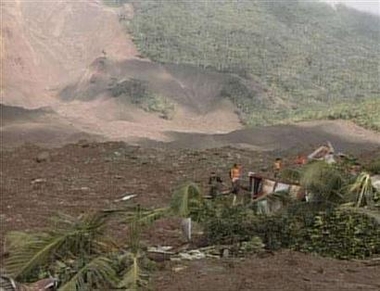|
Philippine landslide village buries bodies and hope
(Reuters)
Updated: 2006-02-20 11:01
Hunting for bodies and burying the dead resumed in the central Philippines on
Monday, with rescuers holding out little hope for survivors in a village of
1,800 entombed by a collapsed mountainside.

Rescuers search for
survivors amidst the debris caused by a landslide in Guinsaugon in the
Philippine province of Leyte in this February 19, 2006 video grab. Rescue
workers launched a last-ditch search on Sunday for schoolchildren buried
under a torrent of mud in the landslide in the central Philippines that
officials fear has wiped out a village of 1,800 people. Unconfirmed
reports that some of the 253 children and staff at the elementary school
in Guinsaugon, a remote farming community, had sent desperate text
messages on Friday, the day the mud engulfed the village, drove the
emergency services on. [Reuters] |
Battling deep, shifting mud and steady rain, search teams continued to focus
on a school packed with more than 250 children and staff when Friday's landslide
engulfed Guinsaugon, a farming community in Southern Leyte province.
"They can see the roof but so far there is no sign of life," Congressman
Roger Mercado told Reuters on Monday.
Unconfirmed reports that some pupils sent desperate mobile phone text
messages on Friday had spurred on rescuers. But now hope has all but
disappeared.
The National Disaster Coordinating Council said 72 bodies had been pulled
from the mud, with 913 villagers still missing.
Bloated and decomposing, 50 recovered bodies were buried on Sunday in mass
graves sprinkled with holy water and lime powder -- a measure Health Secretary
Francisco Duque said was necessary to prevent disease from spreading in the hot,
fetid conditions.
"They are being buried in such a way that they can be exhumed later," Duque
told Reuters.
President Gloria Macapagal Arroyo viewed relief goods and dog teams being
flown from a military airbase in Manila on Monday. She plans to visit the scene
of the disaster, about 675 km (420 miles) southeast of Manila, on Wednesday or
Thursday.
International agencies have also sent supplies, but many of the emergency
goods must be trucked to the area on bad roads and around washed-out bridges.
Although the president had pledged to recover all of the bodies for burial,
Mercado said a decision was likely within days about closing off the devastated
area.
"We will put up a memorial symbol and we will say holy mass for the bereaved
victims of the landslide," he said.
In hospital, survivors told of jumping from roofs to escape the torrent of
mud, which was set off by two weeks of heavy rain. One six-year-old girl
survived by clinging to a coconut tree.
MORE LANDSLIDES
The Philippines is usually hit by about 20 typhoons each year, with residents
and environmental groups often blaming illegal logging or mining for compounding
the damage.
But in a country where most of the 86 million people are Roman Catholic,
commentators, officials and even survivors said the landslide was God's will.
Leyte island itself is no stranger to disaster. In 1991, more than 5,000
people died in floods triggered by a typhoon.
Around 2,000 people from villages near Guinsaugon were evacuated over the
weekend as Defense Secretary Avelino Cruz warned of more potential catastrophes
because rains triggered by the La Nina weather pattern were expected to last
until June.
A warning was issued to people living near mountain slopes on the southerly
tip of Mindanao, another island where a landslide killed five people on Saturday
night. A small landslide hit the eastern island of Negros Oriental but no deaths
were reported.
In Guinsaugon, hundreds of rescuers, backed by U.S. marines sent from annual
exercises with Philippine troops, were warned to tread gingerly or risk sinking
to their deaths.
With little evidence of where the village once stood, search teams relied on
sketches from survivors to pinpoint the school and other buildings.
"It's a total disaster, just horrendous," said Lieutenant Joel Coots, a
medical officer with the U.S. Marines. "It's very difficult to get to the site
because there are just acres and acres of mud and debris."
|